From Soho with Love: Photographs by Allan Tannenbaum
Photographer Allan Tannenbaum talks New York in the Seventies with Richard Boch.
Despite being born in Brooklyn, I never thought I’d wind up in Lower Manhattan with a loft on Murray Street, two blocks below Chambers. It was late 1977, and the streets were still uncharted territory—no doorbell and no lock on the front door of the building. No one lived down there—or so I thought—until I realized I was just an early settler and a bit ahead of the Downtown real estate curve. The photographer Allan Tannenbaum already lived nearby, though he took the long way round from New Jersey to San Francisco and back to New Jersey before touching down two blocks north of Chambers in a loft on Duane Street. Tannenbaum soon found a second home in 1973 at the upstart SoHo Weekly News, and quickly became the newspaper’s indispensable eye. Camera in hand, he began to capture a visual portrait of life in New York City, with a particular focus on the still wild and woolly nether regions of SoHo and what was fast becoming Tribeca.
Everything was happening below Houston Street, from Lafayette across to Sixth Avenue. It was ground zero for the art world and there was old money, new money and no-money swarming the cobblestone streets. It was darkness and light, an incredible mix of who’s who and what the heck is happening next. I was running around trying to figure out how I might fit in while Tannenbaum was already smack in the middle, taking pictures of everything.
I’d see Allan around—on the street, in the clubs, the galleries and at the Academy of Music on Fourteenth Street. We both leaned old school, but when the Punk scene started to explode, it was hard to resist. Once your foot was in the door of CBGB or Max’s, there was really no way out—and then, in the fall of 1978, the Mudd Club happened. It’s where I found myself, and it’s where I got to know Allan Tannenbaum. By now, he was doing covers and features for the SoHo Weekly News, having established himself as a working photographer and photojournalist, and I finally found my place, working the Mudd Club door. The rough and tumble streets of SoHo were on their way to becoming a next-level destination, while Tribeca, anchored by Mudd on White Street and a number of other neighborhood art bars, stood by waiting in the wings.
Decades later, though it seems like yesterday, I can still see Allan taking photos of the crowd outside the club. He was everywhere, and a good part of his archive bears witness to a life and legacy that was lived and built on the streets of Downtown New York City.
Talking with Allan Tannenbaum today about his most recent exhibition, From SoHo With Love at the Morrison Hotel Gallery on Prince Street, his images offer up a gift of dreamlike recollections on the life of a neighborhood—and beyond.
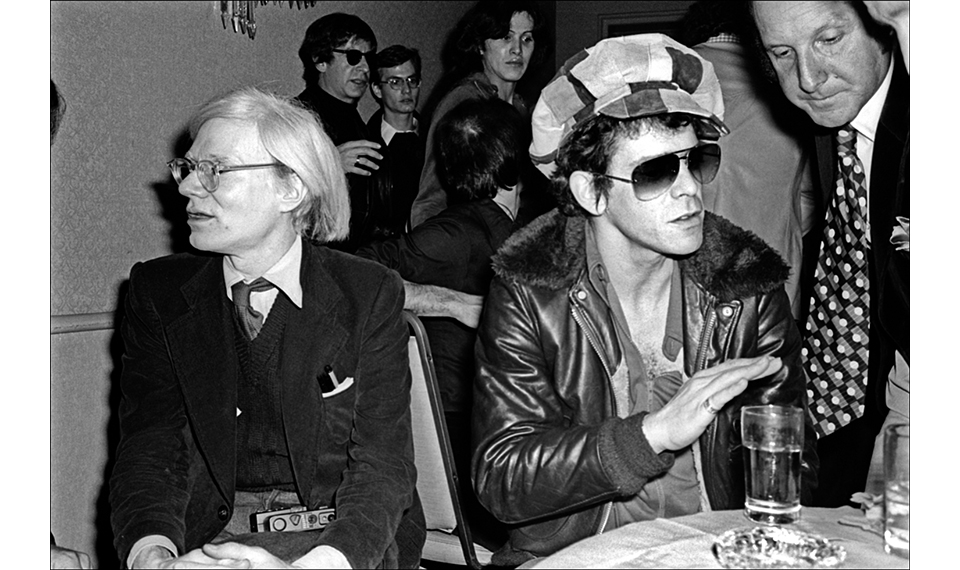
Andy Warhol, Lou Reed and Clive Davis. © Allan Tannenbaum
Richard Boch: Hi Allan, let’s step back into those pioneering days in Lower Manhattan when the streets were empty and even taxi drivers barely knew the area. You arrived in the neighborhood several years before me, and it feels like we’ve been part of the Downtown New York scene forever. We’ve certainly expanded our horizons over the years, but before we step into the here and now, tell me what it was about those steamy, cobblestone streets of SoHo that initially grabbed your attention and your eye?
Allan Tannenbaum: Well, I was a taxi driver in the early 1970s and actually knew the area and would frequently stop at Dave’s Corner at Broadway and Canal for a Lime Rickey to cool down. This was a familiar area and my attraction was almost primordial in that, as a kid growing up in New Jersey, I would come over to lower Manhattan. There was a ferry from Hoboken to Chambers Street, the piers were bustling, and Washington Market was still the city’s central market. The (elevated) West Side Highway was still there and it was amazing. For a kid, it was fascinating, and then years later, I was able to find a place to live in Tribeca. It was a no man’s land but I liked the emptiness and even though the streets were dark at night, there was something going on. Even then, it was a very intriguing and exciting place to be.
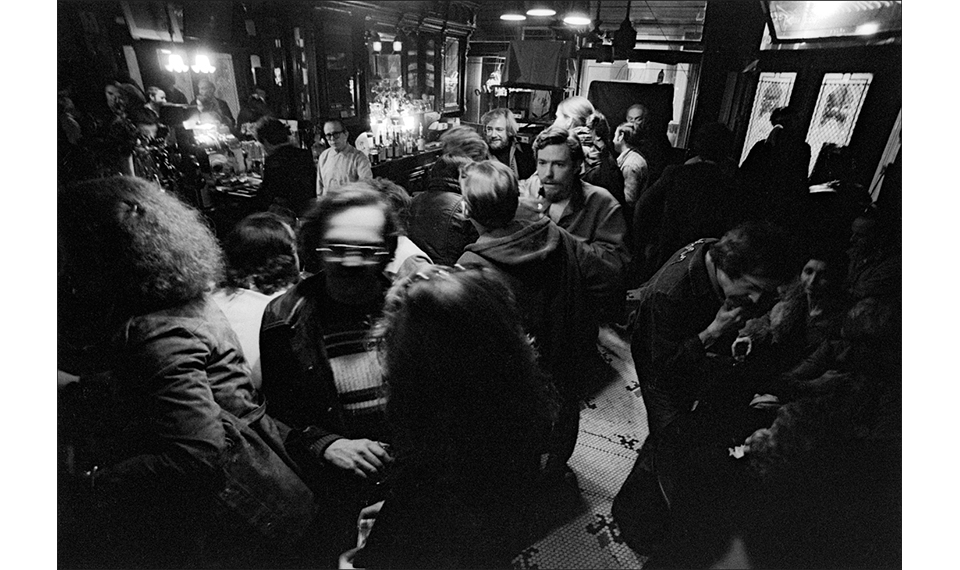
Mike Fanelli behind the bar in Fanelli’s, SoHo favorite artists’ bar. © Allan Tannenbaum
RB: Granted, there was already an eclectic mix of legendary nightspots in SoHo—The Loft on Prince Street, The Zodiac on Mercer and The Ballroom on West Broadway. Then Spring Natural and the Spring Street Bar and Restaurant came along and joined Fanelli on Prince and Mercer Streets, Ken & Bob’s Broome Street Bar and the legendary art canteen FOOD on Prince and Wooster Streets. Those places were, in a sense, ahead of their time, though no one really saw what was coming next. Did you really think the neighborhoods below Houston Street would become the meccas they are today?
AT: Yes, I did, even though I had no idea how much of a megalopolis it would become. Fanelli’s was a great place to hang out in the early days and wandering the streets at night, somebody’s door would be open, you’d go up these rickety stairs and there’d be a party going on with jug wine and a band playing. It’s funny because even then, back in the early 1970s, you could see the neighborhood developing.
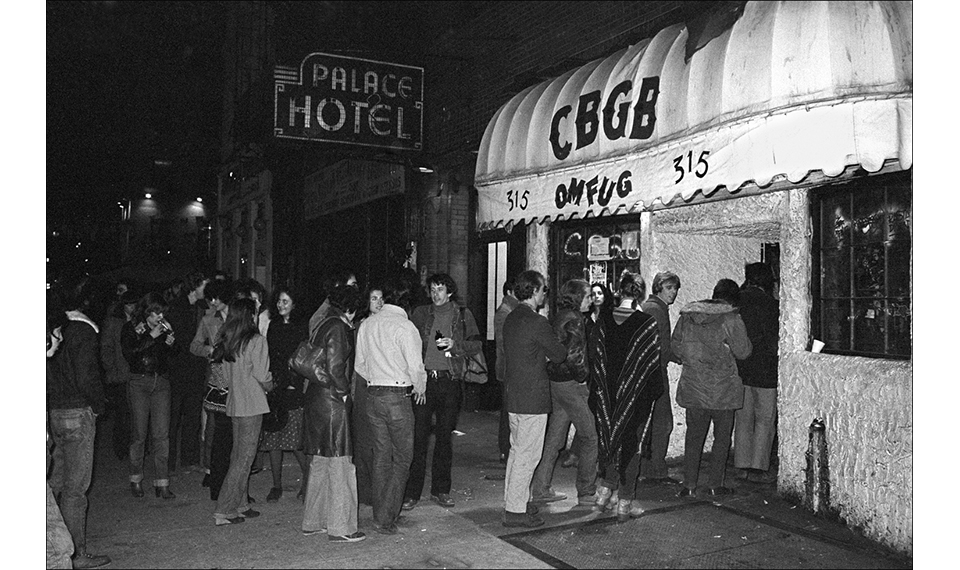
Television fans at CBGB. © Allan Tannenbaum
RB: Oh man, rickety stairs and jug wine—makes me think of the early days on White Street but we’ll get to that next. So, even though the backstreets were still largely deserted, West Broadway in SoHo was becoming somewhat of a boulevard thanks to the gallery scene that was happening. The Leo Castelli Gallery along with Sonnabend Gallery and others took over 420 West Broadway. Ok Harris was already well established and Holly Solomon opened her gallery soon after. The art world descended on SoHo and you were there to capture both the gallery scene and the street scene that these places created. Were you and your camera onto something that other photographers were possibly missing?
AT: I was at the SoHo Weekly News for over eight years, so I saw the neighborhood changing. When I started there, it was an eight-page giveaway and I was paid five dollars a picture. Then came the bigger stores, fancier restaurants and bigger stories—SoHo was beginning to head in a direction that was fairly predictable. My photographs covering the scene include a very wide range of interests—Jazz, Rock ’n’ Roll, nightlife, even politics and religion—and many other aspects of New York City life. Art and the art world were something that always interested me and on Saturdays you could go to any number of openings—drink wine and wander the streets. My work at SoHo News gave me the opportunity to cover all of it.
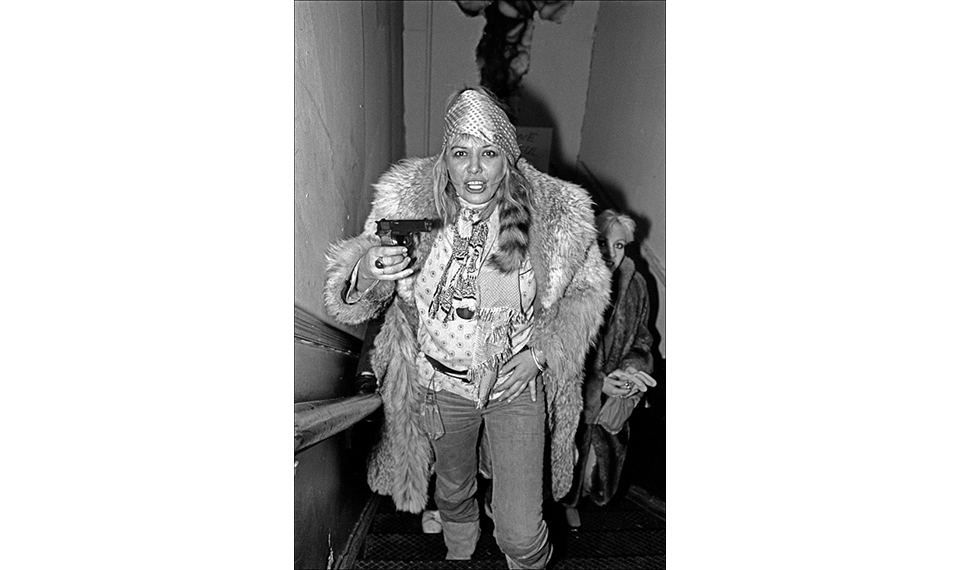
Anita Pallenberg climbs the stairs to the VIP room with a pistol at The Mudd Club. © Allan Tannenbaum
RB: Talking more about nightlife downtown, whether it was the growing number of loft parties, the art-centric performance space that was The Kitchen on Broome Street, or hot-spots like CBGB, Mickey Ruskin’s Lower Manhattan Ocean Club and the Mudd Club (which officially opened Halloween 1978)—SoHo and the neighborhood below Canal Street were on fire. Even notorious spots like Hellfire and The Anvil added fuel to the flames of the downtown open-minded sensibility. Exclusive, based partly on their discreet, hideaway locations, yet egalitarian in spirit and vibe, all these places surely offered juice for you and your 35mm reflex focus. How did you feel stepping into, participating and capturing these wild, nearly anything goes environments?
AT: There was a lot of outrageous stuff going on in the city. SoHo and Tribeca—plus all the other parts of Manhattan, and of course Studio 54—I would even go to places like Plato’s Retreat and Hellfire. Like you said, anything goes, so there was a lot of fascinating imagery for my camera. You never knew what crazy things you might see. Studio 54 was really an incredible place—I would go, I would shoot and then I would head downtown, straight to the Mudd Club and spend the rest of the night hanging out, taking photographs and sometimes wandering out into the sunlight, which was always a bit of a shock.
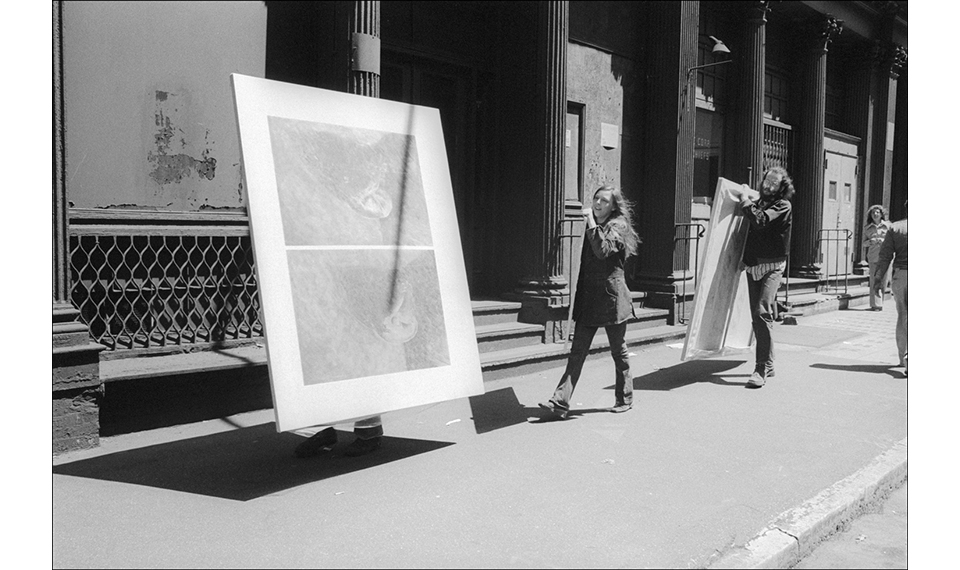
Artists carry paintings between studio and gallery on Broome St. in SoHo. © Allan Tannenbaum
RB: So here we are in the here and now of 2025. Your exhibition, From SoHo With Love, is happening at the Morrison Hotel Gallery’s location on Prince Street. The show brings it all back home and offers up your visionary take on the history and the wonder of a truly unique area of New York City. You’ve taken photos all across the country and in many parts of the world, but what is it about SoHo and downtown that not only defines us but speaks to the heart and soul of the city we love?
AT: Well, Bringing It All Back Home, taken from the great Bob Dylan album, was something I thought of as an alternative title for the show at Morrison Hotel. Then, From SoHo With Love just popped into my head and everybody loved it. It’s been just over fifty years since I started working for the SoHo Weekly News and this exhibit features photographs I took while I was working there. The other thing is, when I see people today walking around SoHo and everything is so far removed from what the neighborhood used to be—it’s all still there in the history, in the streets and in the neighborhood’s famous cast iron buildings. I really love walking around downtown. I feel good here and this show really does bring it all back home.
RB: That’s great, Allan. I totally get it.
***
From Soho With Love is on view at Morrison Hotel Gallery from May 7 – May 21, 2025.
INTERVIEW Richard Boch
FEATURED PHOTOGRAPH Naked Man and Porsche on West Broadway. © Allan Tannenbaum
Richard Boch writes GrandLife’s New York Stories column and is the author of The Mudd Club, a memoir recounting his time as doorman at the legendary New York nightspot, which doubled as a clubhouse for the likes of Jean-Michel Basquiat, Keith Haring, Debbie Harry and Talking Heads among others. To hear about Richard’s favorite New York spots for art, books, drinks, and more, read his Locals interview—here.